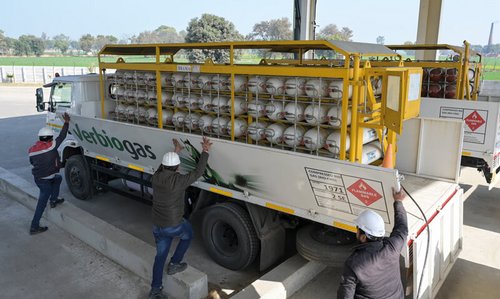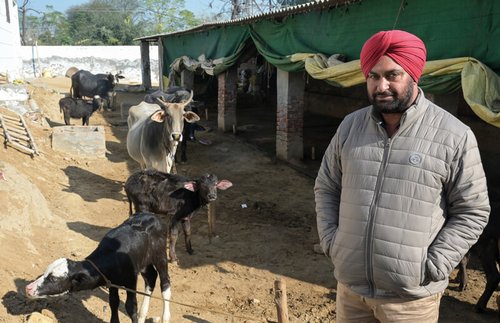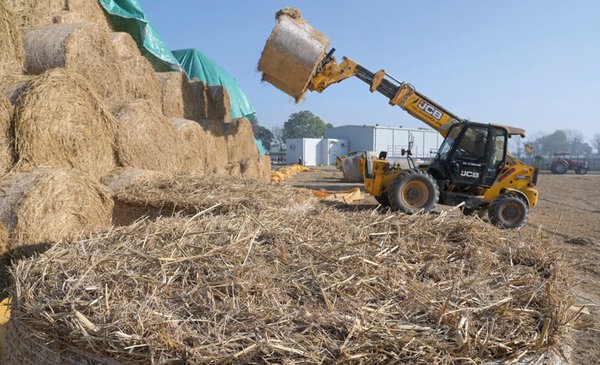 Download this article in magazine layout
Download this article in magazine layout
- Share this article
- Subscribe to our newsletter
BioCNG made in India – not a flash in the pan!
Continuous beeping is coming from the telescopic wheeled loader in the grounds of the brand new biogas plant. The driver takes one large round bale after another from a twelve-metre-high straw stack and drives them to the fermentation line. Several of these 100-metre-long stacks are on the eleven-hectare site of Verbio India, a subsidiary of the German biofuel manufacturer Verbio AG. The plant is located near the town of Lehragaga in the Indian state of Punjab. The bales contain rice straw as well as wheat straw, although the latter is under-represented. According to Plant Manager Pankaj Jain, the company has collected roughly 40,000 tonnes of straw from about 1,000 farmers in the local area − and in the case of sugarcane bagasse, also from further afield − since operations commenced a few months ago. That is a huge volume, which is why the bales are not only deposited directly beside the plant's eight digesters. An additional four interim storage sites have been established where the plant’s feedstock is stacked and covered with tarpaulins. An enormous amount of logistics is involved in ensuring that the straw and bagasse is collected dry from the fields and has retained its quality by the time it reaches the fermenter. This is certainly one of the key factors in ensuring that the first straw fermentation plant of its kind in India, which was inaugurated in the presence of many political celebrities in October 2022, can achieve sustained success.
“Welcome into the Greenzone” says a sign at the entrance to the bioenergy plant, which employs 80 people and required a whopping 25 million euro investment. Production at the plant has not yet been fully ramped up; the 10 MW capacity limit will only be reached with a feedstock intake of around 100,000 tonnes of straw and bagasse per year. But expectations are already high, on the part of both Indian politicians and farmers in the region. On a day-to-day basis, no-one is more aware of this than Pankaj Jain. On this foggy morning, the chemical engineer is constantly moving between the digesters, the feedstock storage site and the growing digestate store to keep an eye on operations. As deliveries of straw arrive, the purified and compressed methane, filled in standard gas cylinders, departs from the plant. Digestate is taken away with lorries and small waggons drawn by tractors. It is brought back to the fields as high-value fertiliser.
Well-established logistics for gas distribution
Roughly 60 tonnes of straw or bagasse per day is fed into the digesters. The compressed BioGas or CBG − a somewhat misleading term used in India because it is actually Compressed Natural Gas (CNG) – is filled directly into the standard 75- to 150-litre gas bottles that are permanently installed on truck trailers. Once a trailer's cylinders are full, it is picked up by a truck and taken to a filling station within a radius of 25 to 100 kilometres. Like Vivek Singia’s filling station, for example, which is located on the main road between Sangrur and Patran. As is customary, not only diesel and petrol are sold there, but also gas. The latter is a commonly used fuel in India. However, drivers filling their tanks at Singia's petrol station are not aware that a quarter of the motor fuel they purchase is CBG (bioCNG), as CBG is not offered separately from fossil fuel.

The compressed biogas is filled directly into gas bottles and taken to a petrol station. Photo: Jörg Böthling
When the CBG load runs out, the trailer with the empty gas cylinders is taken back to the biogas plant − a cycle that did not take long to run smoothly. Sales are going well too, says Jain. Even if the volume of production were to rise threefold, CBG distribution would not present any logistical problems. Logistics for straw and digestate are more complex. “Various models are still being tested. The straw can be dealt with via hired companies or with a plant’s own logistics,” says Ashish Kumar, Managing Director of Verbio India. Kumar works in Chandigarh, the state capital of Punjab, where Verbio India's head office is located. He has come from the capital for a few days to conduct on-site discussions with individual farmers and entire village communities about the issue of straw collection. After his military service in the Indian Navy, Kumar, who is now in his late forties, studied International Business in Leipzig/Germany and then worked for management consultancy EAC in Munich for some time. He is fully convinced that straw fermentation will be very successful in many Indian regions in the future. Why? “The mere fact that the post-harvest burning of rice straw over wide areas, which regularly plunges the whole Punjab into toxic plumes of smoke, will come to an end with our form of utilisation. This aspect is very important to us,” he emphasises. Moreover, straw fermentation creates many jobs in rural areas. One example is Manseet Singh, who drives a wheeled loader at the external straw storage facility 3.5 kilometres away. “My family has a small two-hectare farm in Bhutal Kalan village,” says the 27-year-old, standing in front of a pyramid of straw bales. His income eases the economic pressure on the smallholder family.
Market transparency still lacking
Another important argument is that of sustainable energy production, even though the issue is still far from being afforded the same significance by society at large as it is in Europe, for example. Although biogas production for the fuel sector is economically secured with fixed tariffs within a flexible price corridor, market transparency is still lacking. Anyone filling up a natural gas vehicle in Punjab does not know whether the gas comes from Qatar, Russia or elsewhere, or whether it has been produced from the straw harvested in the region. Consequently, the bioCNG does not fetch a higher price at the pump. Nevertheless, according to the clear commitments made by the Indian central government and the responsible Ministry for New and Renewable Energy in New Delhi, biogas is an important building block on the path towards more climate-friendly, and ideally, carbon-neutral energy production.
Biomass plays an important role in India's overall energy sector, with about one third of the supply being based on renewable raw materials. The hundreds of thousands of mini biogas plants that have been installed in recent decades from Cape Comorin in the South to the mountains of Darjeeling, and whose energy is mainly used for cooking, are not at odds with the large-scale plants for electricity generation and fuel production that have primarily been built in recent years. Both systems exist side by side, as can be seen on Darshan Singh's farm. Singh's family has been fermenting the manure from their ten cows and their offspring for many years, using a simple, small biodigester designed for small-scale farms; the amount of gas they produce easily covers their energy needs for cooking. Singh, who farms roughly 18 hectares of land with his family, is therefore already familiar with biogas generation. This is one of the reasons why he welcomes the large fermentation plant that was built a mere three kilometres away from his farm. “I like to take our rice straw there. Our cattle don't like to eat it anyway because of the high silica content. I almost always used to burn it in the field right after the harvest to keep a clean seedbed for the wheat crop to follow,“ says Singh. But he would not want to give away his own wheat straw. “I need some of it for my animals, and for the rest of it I can get a good price in the marketplace,“ Singh continues. But what about his soils’ humus content if he harvests two crops a year and burns or removes all the biomass? In fact, the organic matter content of his soils is not satisfactory, Singh admits. This is the case for many fields in the Punjab region, the “Land of the five rivers”, which after all is well supplied with water throughout the year from canals and the farms’ own wells. "But then there is also the government-subsidised mineral fertiliser," says Singh. Irrespective of this, he would be happy to accept digestate from Verbio and use it as fertiliser for his fields − “provided I can get it for free”.

Darshan Singh has been fermenting the manure from his cows and their offspring for many years. Photo: Jörg Böthling
“Our nutrient economy is still dominated by NPK,” criticises Verbio manager Kumar. The fertiliser lobby continues to have a great influence on Indian agricultural policy and is blocking more sustainable farming. This is why the Indian Biogas Association recently called for a programme under which the purchase of mineral fertilisers would have to be linked to the purchase of digestate. Such a demand meets with Kumar's instant approval, because the lack of appreciation for digestate means that at present it is very cumbersome and costly for many biogas plants to get it distributed. “In the long run, we need a closed cycle of straw, energy generation and digestate to revitalise Punjab's soils, which have been badly degraded by intensive cultivation over the past decades, ”Kumar maintains. S. S. Gosal, vice chancellor of Punjab Agricultural University in Ludhiana, fully agrees with him. “Humus levels have been declining in recent years, and dramatically dropping groundwater levels caused by widely dominating rice cultivation are forcing a rethink,” Gosal says in his office on the university's huge campus. “In the past, we always focused on the plant; now we focus more and more on the soil and the systems’ interactions in general.“ The change in mindset is also an opportunity for biogas in India − as an integral component of a sustainable farming sector.
Dierk Jensen is a freelance journalist based in Hamburg, Germany.
Contact: dierk.jensen@gmx.de





Add a comment
Be the First to Comment